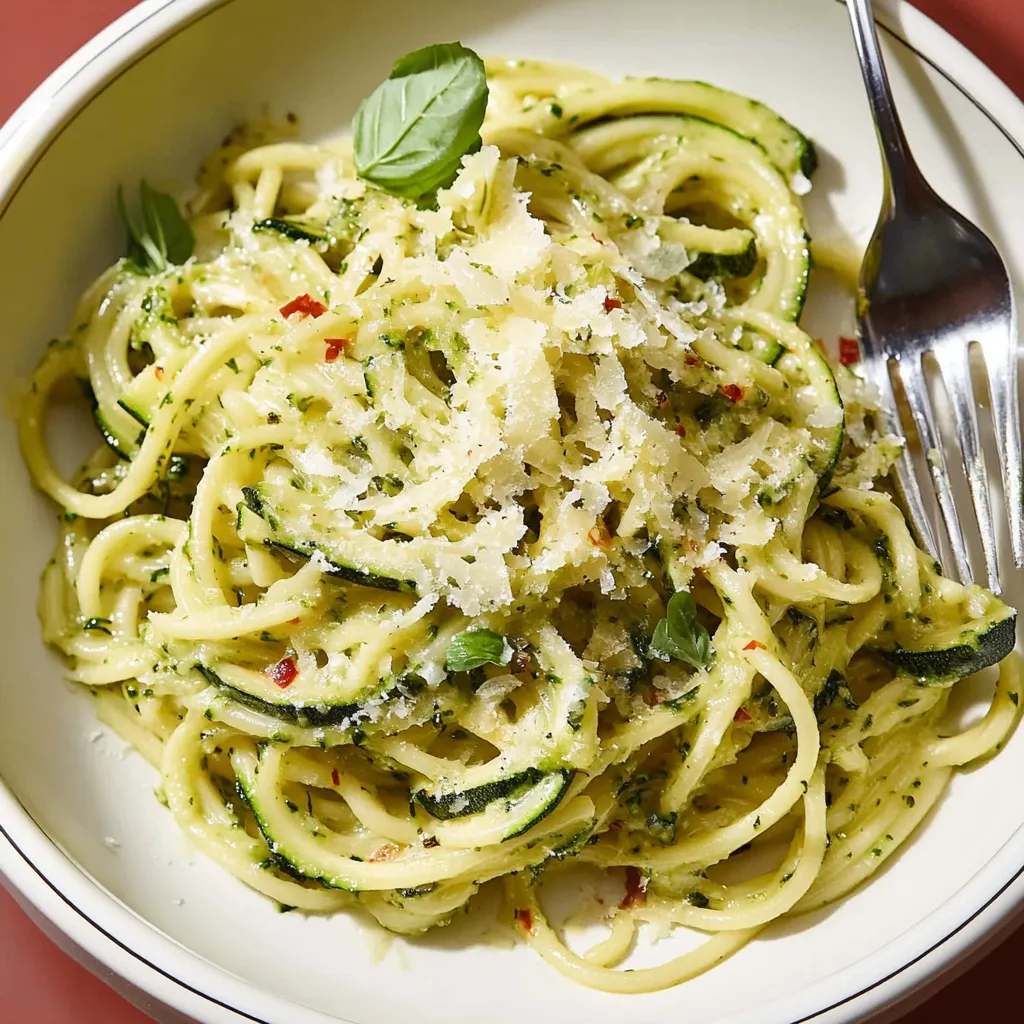 Pin it
Pin it
This creamy zucchini pasta transforms summer's most abundant vegetable into a silky, flavorful sauce that clings beautifully to every strand of spaghetti. Grated zucchini gets sautéed down until it becomes jammy and sauce-like, then gets enriched with garlic, lemon, and plenty of Pecorino cheese. It's the perfect way to use up a huge amount of zucchini while creating something that tastes elegant and restaurant-worthy.
I discovered this technique after watching my neighbor's zucchini plants produce more than her family could possibly eat. I was skeptical that grated zucchini could become a proper pasta sauce, but the first time I watched it transform in the pan - from watery shreds to this glossy, jammy mixture - I was completely hooked. My three-year-old, who normally picks vegetables out of everything, actually asks for "the green pasta" regularly because the zucchini disappears so completely into the sauce.
Essential Ingredients and Selection Tips
- Fresh zucchini: Choose medium-sized zucchini that feel firm and heavy; avoid overly large ones which can be watery and seedy
- Long pasta shapes: Spaghetti or bucatini work best as the sauce clings to the strands; short pasta doesn't carry the delicate sauce as well
- Quality Pecorino Romano: The sharp, funky flavor complements zucchini better than milder Parmesan; buy a wedge and grate fresh
- Fresh garlic and shallots: These aromatics provide essential depth; don't substitute with powdered versions
- Good olive oil: Extra virgin adds flavor and helps the zucchini cook down properly into a rich sauce
- Fresh herbs: Basil and mint are classic, but use what you have; the herbs should be bright green and aromatic
Detailed Step-by-Step Instructions
- Prepare the zucchini properly:
- Wash and trim 2 pounds of zucchini (about 4 medium), then grate them on the large holes of a box grater or in a food processor fitted with the grating disc. Transfer the grated zucchini to a clean kitchen towel or several layers of paper towels, gather the corners, and twist to form a pouch. Squeeze firmly to remove as much excess moisture as possible - this step is crucial for achieving the right sauce consistency.
- Start the aromatics:
- Heat 1/4 cup extra virgin olive oil in a large skillet over medium heat. Add 2 minced shallots and 1/4 teaspoon red pepper flakes (if using), cooking for 2-3 minutes until the shallots are softened and fragrant but not browned. The oil should be gently bubbling around the shallots.
- Cook the zucchini down:
- Add the squeezed, grated zucchini to the skillet with the shallots. Cook, stirring frequently, for 15-20 minutes until the zucchini has cooked down significantly and become jammy and sauce-like. It should look cohesive rather than like separate shreds, and most of the liquid should have evaporated. This patience is key to developing the proper texture.
- Add garlic at the right moment:
- Stir in 4 minced garlic cloves and cook for 1-2 minutes until fragrant. Adding the garlic later prevents it from burning during the long cooking time needed for the zucchini. The mixture should smell amazing at this point.
- Cook pasta with purpose:
- Meanwhile, bring a large pot of well-salted water to a boil and cook 1 pound spaghetti or bucatini according to package directions until al dente. Before draining, reserve 1 cup of the starchy pasta cooking water. Instead of draining in a colander, use tongs to transfer the pasta directly from the pot to the skillet with the zucchini.
- Create the creamy sauce:
- Add 1/2 cup of the reserved pasta water and 1 cup freshly grated Pecorino Romano to the skillet. Toss everything together vigorously for 2-3 minutes, adding more pasta water as needed, until the cheese melts and creates a creamy, glossy sauce that coats each strand of pasta. The starch from the pasta water helps bind everything together.
- Balance the flavors:
- Remove from heat and stir in the zest of 1 lemon and 2 tablespoons fresh lemon juice. Taste and season generously with salt and freshly ground black pepper. The lemon should brighten the entire dish without overpowering the delicate zucchini flavor.
- Finish with fresh herbs:
- Serve immediately in warmed bowls, topped with torn fresh basil leaves, chopped mint, additional lemon zest, and more grated Pecorino. The herbs should be added just before serving to maintain their bright color and fresh flavor.
 Pin it
Pin it
The transformation that happens in that skillet never fails to amaze me. What starts as a pile of watery zucchini shreds slowly concentrates into this rich, silky sauce that tastes like summer in a bowl. My husband, who was initially dubious about zucchini as a main course, now requests this pasta specifically when we have an abundance of summer squash. The fact that it uses so much zucchini at once makes it my secret weapon for managing garden overflow.
Understanding Zucchini Cooking Chemistry
Zucchini is primarily water, which is why proper moisture removal is crucial before cooking. When heated, the remaining cellular structure breaks down and the natural starches and sugars concentrate, creating a naturally thick, flavorful base. The long cooking time allows these flavors to develop and meld while achieving the proper jammy consistency.
Pasta Water Science and Emulsification
The starchy pasta water acts as an emulsifier, helping to bind the grated cheese with the zucchini and oil to create a cohesive sauce. This technique mimics traditional Italian pasta-making where the pasta cooking liquid is always reserved and used to adjust sauce consistency and help everything come together smoothly.
Cheese Selection and Flavor Building
Pecorino Romano's sharp, salty flavor and aged texture make it ideal for this delicate dish. Unlike Parmesan, which can be mild and nutty, Pecorino provides the assertive flavor needed to stand up to the subtle zucchini while still allowing the vegetable to shine. The cheese also helps create the creamy texture without masking other flavors.
Herb and Acid Balance
Fresh herbs and lemon juice serve multiple purposes beyond flavor - they provide color contrast and help cut through the richness of the cheese and oil. The brightness prevents the dish from feeling heavy despite the creamy sauce, making it perfect for warm weather dining.
Texture Development and Timing
The key to this recipe's success lies in understanding when the zucchini has cooked sufficiently. It should look more like a rustic pesto than individual vegetable pieces, with a glossy, cohesive appearance that will coat pasta properly. Rushing this step results in a watery, separated sauce.
This recipe has revolutionized how I think about using up garden abundance. Instead of trying to sneak vegetables into other dishes, this approach celebrates the zucchini as the star while creating something genuinely delicious that everyone actually wants to eat. It's become my go-to example of how simple, seasonal cooking can be both practical and absolutely satisfying.
Frequently Asked Questions
- → Do I need to peel the zucchini first?
- No, leave the skin on! It adds color and nutrients to the dish.
- → Why do I need to squeeze out the zucchini water?
- Removing excess water prevents your pasta from getting watery and helps create that thick, creamy texture.
- → Can I use a different type of pasta?
- Yes! Try penne, rigatoni, or even whole wheat pasta. Just cook according to package directions.
- → What if I don't have shallots?
- Use half a yellow onion instead. Dice it small and cook the same way.
- → How do I store leftover zucchini pasta?
- Keep it in the fridge for up to 3 days. Add a splash of water when reheating to loosen the sauce.
- → Can I make this without cheese?
- Sure! Skip the cheese or try nutritional yeast for a dairy-free option that still adds flavor.
